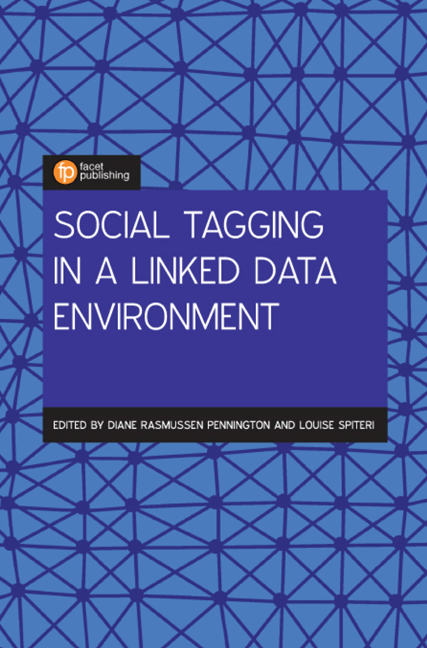Book contents
- Frontmatter
- Contents
- List of figures and tables
- Contributors
- 1 Introduction: the continuing evolution of social tagging
- 2 Tagging the semantic web: combining Web 2.0 and Web 3.0
- 3 Social tags for linked data with Resource Description Framework (RDF)
- 4 Social tagging and public policy
- 5 Hashtags and library discovery systems
- 6 Social information discoverability in Facebook groups: the need for linked data strategies
- 7 #FandomCommunication: how online fandom utilises tagging and folksonomy
- 8 Keys to their own voices: social tags for a dementia ontology as a human right
- 9 Social tagging and the enterprise: an analysis of social tagging in the workplace
- 10 Use and effectiveness of social tagging recommender systems
- Index
3 - Social tags for linked data with Resource Description Framework (RDF)
Published online by Cambridge University Press: 01 June 2019
- Frontmatter
- Contents
- List of figures and tables
- Contributors
- 1 Introduction: the continuing evolution of social tagging
- 2 Tagging the semantic web: combining Web 2.0 and Web 3.0
- 3 Social tags for linked data with Resource Description Framework (RDF)
- 4 Social tagging and public policy
- 5 Hashtags and library discovery systems
- 6 Social information discoverability in Facebook groups: the need for linked data strategies
- 7 #FandomCommunication: how online fandom utilises tagging and folksonomy
- 8 Keys to their own voices: social tags for a dementia ontology as a human right
- 9 Social tagging and the enterprise: an analysis of social tagging in the workplace
- 10 Use and effectiveness of social tagging recommender systems
- Index
Summary
Introduction
Social tags are often considered as another type of metadata, since they provide information about the resources for users’ needs (Kim et al., 2010; Passant et al., 2009). In addition, its social aspect allows tags to become a form of collective knowledge. The term folksonomy, a term created by combining ‘folk’ and ‘taxonomy’ to indicate a user-driven collective taxonomy generated from tags (Vander Wal, 2007), also reflects such perspectives.
As simple keywords assigned to a resource, tags have some limitations as resource descriptions. First, simple keyword tags without any context encounter problems with ambiguity in their semantic meanings (Guy and Tonkin, 2006; Passant et al., 2009). A good example of this limitation is homograph terms such as apple, which can mean a fruit or a company. Second, because the tagging systems allow users to input free form text as tags, the tag terms may vary in their forms and selections. This could be related to the use of synonymous terms such as car and automobile, where users can select one or the other for the same concept. Another example could be related to different tag term forms. For instance, user-generated compound tag forms such as semantic web, SemanticWeb, Semweb, semantic-web and so forth, are considered heterogeneous in tagging systems and when computers process tags (Guy and Tonkin, 2006; Passant et al., 2009; Syn, 2014). In addition to these cases, there can be additional problems of tag variations that occur due to human errors such as misspelling. Third, a folksonomy does not have a concrete structure; unlike the hierarchical structure of controlled vocabularies, a folksonomy is considered to be a flat organization (Shirky, 2005). In addition, depending on users’ contributions, a tag set may change over time, making a folksonomy dynamic (Lin et al., 2012; Mika, 2007). Finally, there is an issue with the use of tag sets, as user tags are dependent on tagging systems (Gruber, 2007; Kim et al., 2010; Mika, 2007). Various types of systems and applications offer tagging features, including bookmarking systems, such as CiteULike (www.citeulike.org), photo-sharing systems, such as Flickr (www.flickr.com) and Instagram (www.instagram.com), microblogging systems, such as Twitter (https://twitter.com) and library online public access catalogue (OPAC) systems, such as BiblioCommons (www.bibliocommons.com).
- Type
- Chapter
- Information
- Social Tagging for Linking Data Across Environments , pp. 39 - 58Publisher: FacetPrint publication year: 2018



